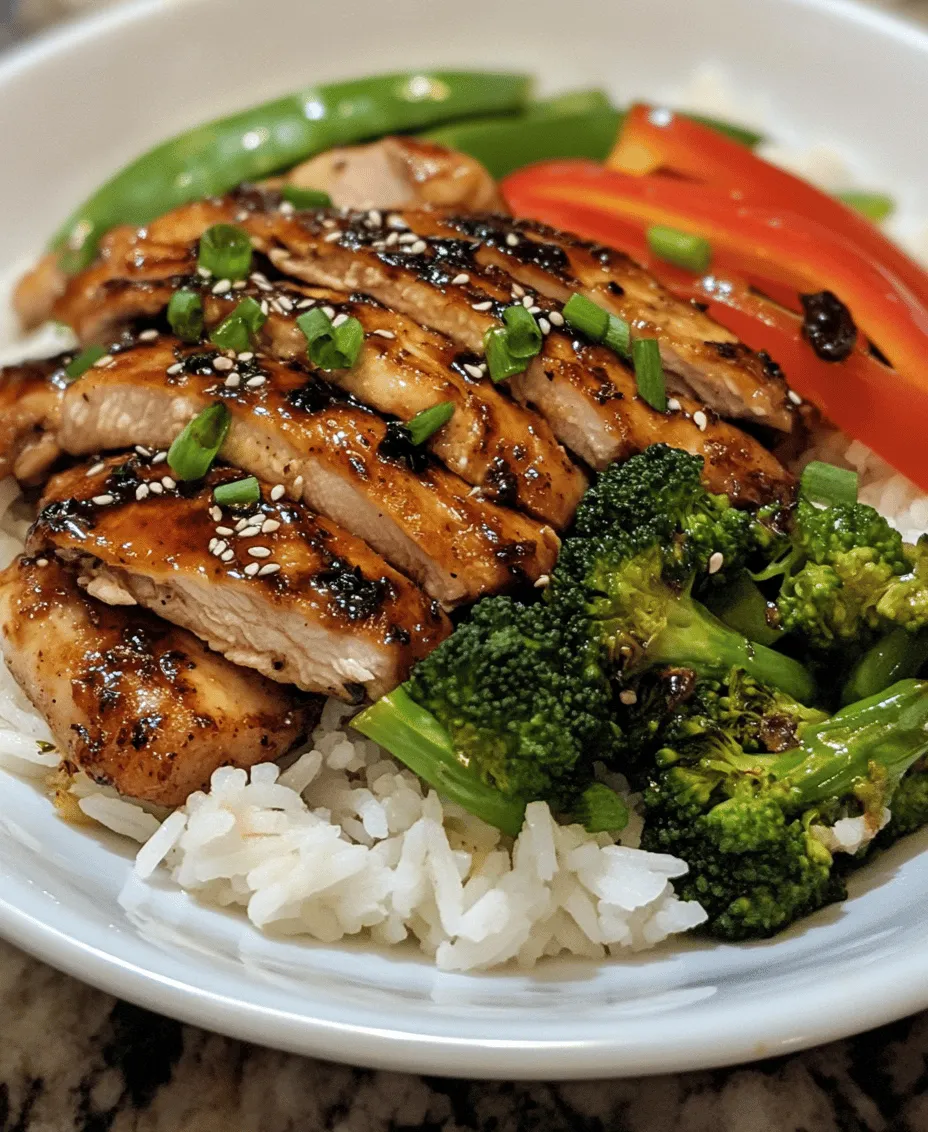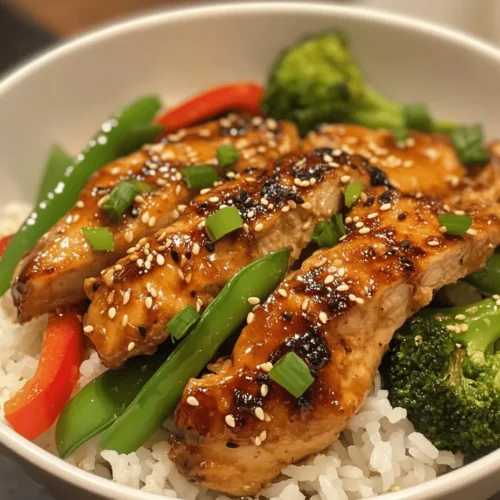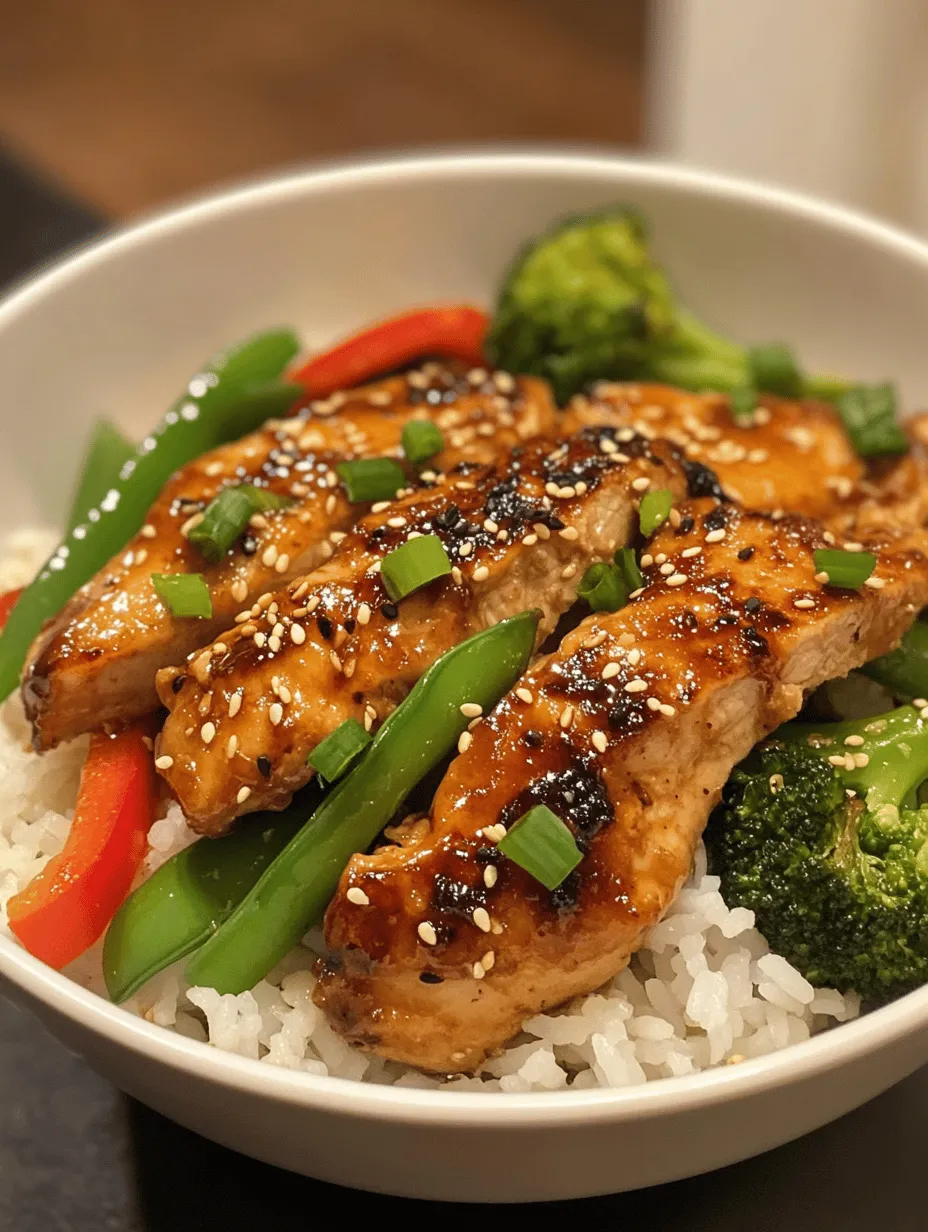Introduction
The Savory Teriyaki Chicken Rice Bowl is a beloved dish that showcases the best of Asian cuisine, combining tender chicken, vibrant vegetables, and perfectly cooked rice, all enveloped in a rich, flavorful teriyaki sauce. This dish has gained immense popularity not only for its mouthwatering taste but also for its beautiful presentation and varied textures. Each bite offers a delightful balance between the sweet, savory notes of the teriyaki sauce and the crunch of fresh vegetables, making it a feast for both the eyes and the palate.
In today’s fast-paced world, the Savory Teriyaki Chicken Rice Bowl stands out as an ideal weeknight meal. Its straightforward preparation allows busy home cooks to whip up a delicious dinner without spending hours in the kitchen. With just a few simple steps, you can create a wholesome meal that the entire family will love.
This article will guide you through the essential ingredients, preparation steps, and cooking techniques required to master this dish, ensuring that you can enjoy restaurant-quality teriyaki chicken right at home.
Understanding the Ingredients
Overview of Key Ingredients and Their Roles in the Dish
To create a mouthwatering Savory Teriyaki Chicken Rice Bowl, it is crucial to select high-quality ingredients that work harmoniously together. The primary components include chicken thighs, jasmine rice, a medley of colorful vegetables, and a homemade teriyaki sauce. Each ingredient plays a significant role in achieving the perfect flavor and texture balance.
Chicken Thighs: Why They’re Preferred Over Chicken Breasts for This Recipe
When it comes to the protein in your rice bowl, chicken thighs are the star of the show. While chicken breasts may be a go-to choice for many, chicken thighs offer several advantages that make them ideal for this dish.
Firstly, chicken thighs are inherently juicier and more flavorful than breasts. Their higher fat content contributes to a richer taste and a tender texture, which is essential for absorbing the savory teriyaki sauce. Secondly, thighs are less prone to drying out during cooking, ensuring that every piece remains succulent and delicious. This makes them the perfect choice for a dish that demands both taste and texture.
Jasmine Rice: Characteristics and Why It Complements the Teriyaki Flavor
The foundation of any great rice bowl is the rice itself, and jasmine rice is the ideal choice for this recipe. Known for its fragrant aroma and slightly nutty flavor, jasmine rice brings an additional layer of complexity to the dish.
When cooked, jasmine rice achieves a fluffy texture that pairs perfectly with the teriyaki chicken and vegetables. Its subtle sweetness complements the bold flavors of the teriyaki sauce without overpowering them. Furthermore, jasmine rice is a staple in many Asian cuisines, making it a natural fit for this dish.
Vegetables: Nutritional Benefits of Broccoli, Red Bell Pepper, and Snap Peas
A well-rounded rice bowl isn’t just about the protein and rice; it’s also about incorporating vibrant vegetables that add both color and nutrition. For our Savory Teriyaki Chicken Rice Bowl, we recommend using broccoli, red bell pepper, and snap peas.
– Broccoli is rich in vitamins C and K, along with dietary fiber, making it a nutritious addition. Its slight bitterness contrasts beautifully with the sweetness of the teriyaki sauce.
– Red bell peppers are not only visually appealing but also packed with antioxidants and vitamins A and C. Their natural sweetness enhances the overall flavor profile of the dish.
– Snap peas provide a satisfying crunch and are an excellent source of vitamins A, C, and K. They also add a pop of color to the bowl, making it visually enticing.
Together, these vegetables contribute essential nutrients while adding texture and flavor that elevate the entire dish.
Teriyaki Sauce: Traditional Components and Variations
The heart of the Savory Teriyaki Chicken Rice Bowl lies in its sauce. Teriyaki sauce is traditionally made from a combination of soy sauce, sake, mirin, and sugar, resulting in a sweet and savory glaze that beautifully coats the chicken.
In our recipe, we’ll create a homemade teriyaki sauce that balances sweetness and saltiness, allowing you to customize the flavors to your liking. While the basic components are essential, variations can include adding garlic or ginger for an aromatic kick, or even sesame oil for a nutty finish. The beauty of making your own teriyaki sauce lies in the ability to control the ingredients and tailor them to suit your taste preferences.
Preparation of Teriyaki Sauce
Creating a homemade teriyaki sauce is not only rewarding, but it also enhances the overall flavor of your Savory Teriyaki Chicken Rice Bowl. Here’s a step-by-step guide to help you craft the perfect sauce.
Step-by-Step Guide on Making Homemade Teriyaki Sauce
1. Gather Your Ingredients: For a basic teriyaki sauce, you’ll need soy sauce, honey (or brown sugar), rice vinegar, garlic, ginger, and cornstarch.
2. Combine the Base Ingredients: In a small saucepan, combine 1 cup of soy sauce, 1/4 cup of honey (or brown sugar), and 1/4 cup of rice vinegar.
3. Add Aromatics: Finely mince 2 cloves of garlic and 1 tablespoon of fresh ginger, then add them to the saucepan. These ingredients will bring a fragrant aroma and depth to your sauce.
4. Heat the Mixture: Place the saucepan over medium heat and whisk the ingredients together until they are well combined and the sugar has dissolved.
5. Thicken the Sauce: To achieve the desired consistency, mix 1 tablespoon of cornstarch with 2 tablespoons of water in a small bowl to create a slurry. Gradually whisk this mixture into the saucepan as it heats, continuing to stir until the sauce thickens, which should take about 2-3 minutes.
6. Taste and Adjust: Once the sauce has thickened, taste it and adjust the flavors as needed. If you prefer a sweeter sauce, feel free to add more honey or sugar. For a saltier kick, a splash of soy sauce will do the trick.
7. Cool and Store: Remove the saucepan from the heat and let the sauce cool before using it in your rice bowl. If not using immediately, store it in an airtight container in the refrigerator for up to a week.
Importance of Balancing Flavors
The key to an exceptional teriyaki sauce lies in balancing the flavors. The sweetness from honey or brown sugar should harmonize with the saltiness of soy sauce, while the acidity from rice vinegar adds brightness. This balance is crucial in ensuring the sauce complements the chicken without overwhelming it.
Tips for Achieving the Right Consistency with Cornstarch
When using cornstarch to thicken your teriyaki sauce, it’s essential to mix it with cold water before adding it to the hot sauce. This prevents clumping and ensures a smooth consistency. Additionally, be careful not to overcook the sauce after adding the cornstarch, as it can become too thick. Aim for a syrupy texture that will cling beautifully to the chicken and vegetables.
Cooking the Rice
A perfect rice bowl starts with perfectly cooked rice. Here’s how to achieve that with jasmine rice.
Techniques for Rinsing and Cooking Jasmine Rice Perfectly
1. Rinse the Rice: Begin by measuring out 1 cup of jasmine rice. Rinse it under cold water in a fine-mesh strainer until the water runs clear. This step removes excess starch, which can make the rice sticky and clump together during cooking.
2. Soak (Optional): For extra fluffy rice, consider soaking the rinsed rice in water for 30 minutes before cooking. This allows the grains to absorb some moisture and helps them cook evenly.
3. Cooking the Rice: In a medium saucepan, combine the rinsed (and soaked) jasmine rice with 1 1/2 cups of water. You can also use chicken broth for added flavor. Bring the mixture to a boil over medium-high heat.
4. Simmer: Once boiling, reduce the heat to low, cover the saucepan, and let it simmer for about 15 minutes, or until the rice has absorbed all the liquid.
5. Let it Rest: After the cooking time is up, remove the saucepan from the heat and let it sit, covered, for an additional 10 minutes. This resting period allows the rice to steam and become tender.
Comparison Between Cooking in Water Versus Chicken Broth
Using water for cooking jasmine rice will yield a neutral flavor, making it a versatile base for any dish. However, cooking it in chicken broth infuses the rice with a savory depth, enhancing the overall taste of your Savory Teriyaki Chicken Rice Bowl. If you’re looking to elevate the flavor profile, opt for chicken broth; your rice will be anything but plain.
Importance of Letting the Rice Rest After Cooking
Allowing the rice to rest after cooking is a crucial step that many often overlook. This process allows the steam to redistribute throughout the grains, ensuring that each bite is fluffy and tender. If you skip this step, your rice may end up gummy or unevenly cooked, compromising the quality of your rice bowl.
Cooking the Chicken
The final step in creating your Savory Teriyaki Chicken Rice Bowl involves cooking the chicken thighs to perfection. Here’s how to achieve that golden brown exterior while keeping the meat juicy and tender.
Techniques for Perfectly Cooking Chicken Thighs: Achieving a Golden Brown Exterior
1. Prepare the Chicken: Start by trimming any excess fat from the chicken thighs and patting them dry with paper towels. This step is essential for achieving a nice sear.
2. Seasoning: Season the chicken thighs generously with salt and pepper. You can also add a touch of garlic powder for an extra flavor boost.
3. Heat the Pan: In a large skillet, heat 1 tablespoon of oil (vegetable or sesame oil works well) over medium-high heat. Ensure the oil is hot before adding the chicken.
4. Sear the Chicken: Carefully place the chicken thighs in the skillet, skin side down if applicable. Avoid overcrowding the pan, as this can lower the temperature and prevent browning. Cook for about 5-7 minutes without moving the chicken, allowing it to develop a golden brown crust.
5. Flip and Cook Through: Once the underside is golden, flip the chicken thighs and cook for an additional 5-7 minutes, or until the internal temperature reaches 165°F (75°C). This ensures the chicken is cooked through while remaining juicy.
6. Glaze with Teriyaki Sauce: In the last minute of cooking, brush the chicken thighs with the homemade teriyaki sauce, allowing it to caramelize slightly. This adds a beautiful glaze and intensifies the flavors.
By following these techniques, you’ll achieve perfectly cooked chicken thighs that are both visually appealing and deliciously flavorful, setting the stage for an unforgettable Savory Teriyaki Chicken Rice Bowl.
As we continue, we’ll delve into the final assembly of the bowl, layering the components to create a visually stunning and satisfying meal that’s sure to impress your family and friends. Stay tuned for the next part of this journey into the world of savory teriyaki delights!

Seasoning Tips to Enhance Flavor Without Overpowering the Teriyaki Sauce
When crafting your savory teriyaki chicken rice bowl, the seasoning is crucial. The teriyaki sauce itself is flavorful and rich, so it’s important to enhance rather than overpower it. Consider using light soy sauce or low-sodium soy sauce to maintain balance. A sprinkle of garlic powder or freshly minced garlic can add depth without overwhelming the dish. Ginger, whether fresh or powdered, complements teriyaki beautifully and can be used sparingly for that extra zing.
Moreover, a touch of black pepper can provide a subtle kick, while sesame oil—used in moderation—adds a fragrant richness. Remember, the goal is to elevate the teriyaki flavor, not mask it. Taste as you go; this is key to achieving a harmonious balance in your dish that will leave your taste buds wanting more.
Resting the Chicken: Why It’s Crucial for Juiciness
After cooking the chicken, it’s essential to let it rest before slicing. This step is often overlooked, but it’s crucial for maintaining juiciness. When chicken is cooked, the juices are forced toward the center. If you cut into it right away, those juices will escape, leaving you with dry meat. Allow the chicken to rest for about 5-10 minutes after cooking. This resting period lets the juices redistribute throughout the meat, ensuring that every bite is succulent and flavorful.
Sautéing the Vegetables
Importance of Cooking Vegetables to Retain Their Color and Nutrients
In your teriyaki chicken rice bowl, the vegetables play a vital role not only in flavor but also in nutrition and presentation. Cooking vegetables properly ensures they retain their vibrant colors and essential nutrients. Overcooking can lead to dull, mushy vegetables that lack both visual appeal and nutritional value.
Stir-Frying Techniques for Optimal Texture: Tender-Crisp vs. Overcooked
Stir-frying is an excellent method to achieve tender-crisp vegetables, which maintain their nutrients and bright colors. For the best results, heat your pan or wok until it’s hot before adding oil. This high heat allows for quick cooking and minimal moisture loss.
Add the vegetables in stages, starting with firmer ones like carrots or bell peppers, followed by softer vegetables like broccoli or snap peas. Aim for a cooking time of 2-3 minutes for a tender-crisp finish; the vegetables should be vibrant and slightly crisp. If overcooked, they will lose their color and nutrients, resulting in a less appealing dish.
Suggestions for Alternative Vegetables That Can Be Used
Feel free to customize your teriyaki chicken rice bowl with a variety of vegetables. Broccoli, bell peppers, and snap peas are popular choices, but don’t hesitate to experiment. Zucchini, bok choy, or even shiitake mushrooms can add unique flavors and textures. For a touch of sweetness, consider adding sliced baby corn or carrots. The key is to ensure that your vegetables complement the teriyaki sauce and chicken, providing balance and variety.
Bringing It All Together
Combining Chicken, Vegetables, and Sauce: Ensuring Even Distribution of Flavors
Once your chicken and vegetables are prepped, it’s time to bring everything together. In a large mixing bowl, combine the sliced chicken with the sautéed vegetables. Drizzle the teriyaki sauce over the top and gently toss to ensure every piece is coated evenly. This step is crucial for flavor distribution—each bite should offer a harmonious blend of savory chicken, crisp vegetables, and the rich teriyaki sauce.
Importance of Reheating Briefly to Blend Flavors Without Overcooking
If you prepared the chicken and vegetables separately, you may want to briefly reheat the mixture in the pan. This ensures that the flavors meld together beautifully. However, keep the heat low and the time short—just 1-2 minutes should suffice. The goal is to warm everything through without further cooking, which could lead to overcooked chicken or mushy vegetables.
Assembling the Rice Bowl
Presentation Tips for a Visually Appealing Dish
A well-presented dish enhances the dining experience. Start by placing a generous scoop of fluffy cooked rice at the bottom of each bowl. Then, artfully arrange the teriyaki chicken and vegetable mixture on top. Consider using contrasting colors for visual appeal: vibrant green snap peas alongside deep orange carrots create a colorful and inviting dish.
Suggestions for Garnishing with Green Onions and Sesame Seeds
To elevate the presentation, garnish the rice bowl with sliced green onions and a sprinkle of sesame seeds. The green onions add a fresh, zesty note, while sesame seeds contribute a nutty crunch. For an extra layer of flavor, drizzle a small amount of additional teriyaki sauce on top right before serving.
How to Serve: Individual Bowls vs. Family-Style Presentation
When it comes to serving your teriyaki chicken rice bowl, consider your audience and occasion. Individual bowls make for a polished presentation and allow everyone to enjoy their meal at their own pace. Alternatively, a family-style presentation can encourage sharing and create a warm, communal dining atmosphere. Place the rice and toppings in separate bowls on the table, allowing guests to customize their bowls to their liking.
Nutritional Insights
Breakdown of Nutritional Content Per Serving
The savory teriyaki chicken rice bowl is not only delicious but also nutritious. A typical serving includes lean protein from the chicken, complex carbohydrates from the rice, and a variety of vitamins and minerals from the vegetables. On average, one serving contains approximately:
– Calories: 450-500
– Protein: 30-35g
– Carbohydrates: 60-65g
– Fat: 10-15g
These figures may vary depending on specific ingredient choices and portion sizes, so it’s beneficial to calculate based on your recipe variations.
Benefits of a Balanced Meal: Protein, Carbs, and Vegetables
This meal is a great example of balance. The chicken provides high-quality protein, essential for muscle repair and overall health. The rice offers complex carbohydrates, providing sustained energy, while the vegetables contribute fiber, vitamins, and minerals critical for various bodily functions. This combination not only keeps you satiated but also supports a healthy lifestyle.
Discussion on Dietary Considerations (Gluten-Free Options, Low-Sugar Alternatives)
If you or your guests have dietary restrictions, this recipe can easily be adapted. For gluten-free options, substitute regular soy sauce with gluten-free tamari or coconut aminos. If you wish to reduce sugar, consider using a low-sugar teriyaki sauce or making your own using natural sweeteners like honey or maple syrup in moderation. These adjustments allow everyone to enjoy this delightful dish without compromising their dietary needs.
Conclusion
The savory teriyaki chicken rice bowl is a wholesome and delicious meal that can be customized to suit various tastes and dietary preferences. It combines tender chicken, crisp vegetables, and a flavorful teriyaki sauce over a bed of fluffy rice, creating a delightful dining experience that is both satisfying and nutritious.
We encourage you to try this recipe and make it your own by experimenting with different vegetables or adjusting the seasoning to your liking. Cooking is an opportunity to express creativity and share joy with loved ones. So gather your ingredients, embrace the process, and enjoy the delightful flavors of this teriyaki chicken rice bowl. Whether it’s a family dinner or a meal prep for the week, this dish is sure to become a favorite at your table. Happy cooking!



